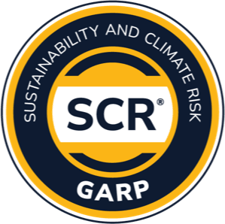Sustainability and Climate Risk (SCR®)
SCR Required Readings
The SCR curriculum includes a selection of online material from leading academics and practitioners. These online readings are required and may be reflected in the SCR Exam questions.
Chapter 1. Foundations of Climate Change: What Is Climate Change?
No required online readings
Chapter 2. Sustainability
“UNEP FI Principles For Responsible Banking,” United Nations Environment Programme Finance Initiative. (pages 3-38).
The specific Learning Objectives for this online reading are as follows:
-
Explain the requirements and suggested measures to take for each principle of responsible banking.
-
Understand and describe how banks have implemented the responsible banking principles, along with the benefits of implementing these principles.
“UNPRI Principles For Responsible Investment,” Principles for Responsible Investment, 2021.
The specific Learning Objective for this online reading is as follows:
-
Identify the six principles of responsible investment and potential ways to achieve them.
Chapter 3. Climate Change Risk
“Risk Management Fundamentals,” Global Association of Risk Professionals (GARP), December 2022.
The specific Learning Objectives for this online reading are as follows:
-
Define the major categories of financial risk faced by organizations.
-
Understand how risk managers identify, measure, and manage credit risk, market risk, liquidity risk, and operational risk.
Chapter 4. Sustainability and Climate Policy, Culture, and Governance
“A call for action: Climate change as a source of financial risk,” Network for Greening the Financial System (NGFS), April 2019. (pages 4-9).
The specific Learning Objectives for this online reading are as follows:
-
Describe the six Network for Greening the Financial System (NGFS) recommendations for central banks, supervisors, policymakers, and financial institutions to manage environmental and climate-related risks.
-
Explain how the NGFS recommendations can guide the financial sector in achieving the objectives of the Paris Agreement.
“The GHG Protocol: A corporate reporting and accounting standard (revised edition),” The Greenhouse Gas Protocol and World Business Council for Sustainable Development (WBCSD), March 2004. (Chapters 1, 3, 4).
The specific Learning Objectives for this online reading are as follows:
-
Describe greenhouse gas accounting and reporting principles.
-
Explain the concept and importance of operational boundaries in greenhouse gas accounting.
Chapter 5. Green and Sustainable Finance: Markets and Instruments
No required online readings
Chapter 6. Climate Risk Measurement and Management
“Implementing the Recommendations of the Task Force on Climate-related Financial Disclosures,” Task Force on Climate-related Financial Disclosures, October 2021. (pages 52-54).
The specific Learning Objectives for this online reading are as follows:
-
Understand the key advantages and disadvantages of common carbon footprint and exposure metrics.
-
Calculate the weighted average carbon intensity of investments, total carbon emissions, and carbon footprint, given a set of inputs.
Chapter 7. Climate Models and Scenario Analysis
No required online readings
Chapter 8. Net Zero
No required online readings
Chapter 9. Climate and Nature Risk Assessment
No required online readings
Chapter 10. Transition Planning and Carbon Reporting
No required online readings
Ready to become a climate risk leader?
Early registration for the April 2026 SCR Exam is now open.

